- Home
- The special bond between man and horse at Dennenhof equestrian centre: the secret of hippotherapy
The special bond between man and horse at Dennenhof equestrian centre: the secret of hippotherapy
17/02/2025 - 09:00
In an inspiring conversation with Didier Tytgadt and Laurens Van Hoof of Manege (Equestian Centre) Dennenhof, in Belgium, we delve into the remarkable world of hippotherapy - a practice where horses provide more than just physical exercise; they foster mental resilience and build self-confidence. Nestled in Landegem, Manege Dennenhof has served as a sanctuary for children and adults of all abilities for decades. Through the unwavering dedication of volunteers and staff, this non-profit organization ensures that therapeutic sessions remain accessible, overcoming numerous challenges along the way. Join us as we explore the profound bond between humans and horses, discover how it transforms lives, and learn how Team TerraCottem is contributing to this incredible mission!
| Interviewers: Dominique Clicteur - Davy Ottevaere |
Laurens and Didier, we’re here at the recommendation of our colleague Dominique Clicteur, who holds your organization in high regard. Dominique, an avid horse enthusiast and owner herself, selected Dennenhof vzw as the charity for our team challenge, “Team TerraCottem walks for charity”.
Dominique, before we get started, could you briefly explain why you chose Dennenhof vzw?
Dominique
When our team was invited to propose charities for the 2025 ‘TerraCottem walks for charity’ initiative, Manege Dennenhof VZW was the first organisation that came to mind. I know Laurens and his family through our shared passion for horse riding, as well as through the cross-country events in Merendree, where I assist with organising. Manege Dennenhof provides hippotherapy, which has a profound impact on the lives of people with disabilities, and their work truly deserves support. I was thrilled—and proud—when ‘my’ project was selected.
"Horses play a very important role in my life. They give me energy, help me relax and are a way for me to meet new people and build social contacts. Thanks to them, I feel connected with others and with myself."
| Who is Dominique (nickname Mieke) Clicteur? Meet the lady here, who does the bookkeeping for TerraCottem. |
|---|
 |
Thank you for taking the time to meet with us, gentlemen. Could you briefly introduce yourselves so our readers can get to know the people we’re sitting down with today?
Didier
Certainly. My name is Didier Tytgadt, and I’ve been involved with Manege Dennenhof since the late 1980s. Initially, I came on board through The Round Table, one of our largest sponsors. Later, when I turned 40 and had to step away from The Round Table because of the age limit, I became an independent director. Three years ago, I took on the role of chairman of Dennenhof vzw, after previously serving as treasurer and in other roles. Professionally, I owned a construction company in Ostend, which enabled me to contribute to the development of the facility. For example, I helped expand the indoor stables to provide more accommodations and ensure we had enough horses available for hippotherapy.
Laurens
My name is Laurens Van Hoof, and I’ve been the coordinator of Manege Dennenhof since 2018. Essentially, I oversee the day-to-day operations of the equestrian centre, under the guidance of Didier and the Board of Directors. My connection with the riding school goes back quite a long way—I first joined as an eight-year-old (laughs). My dad worked at MFC Ten Dries next door, so during holidays, I’d tag along and help out with the horses, often alongside Vincent Marecaux, one of the founders of the equestrian center.
When I turned 16, I became an instructor for holiday camps and weekend lessons. After that, I stepped away from the centre for a few years due to my studies and later worked in the car industry for five years, primarily abroad. But when I heard about the opening for a coordinator position, I didn’t have to think twice. My passion has always been with horses—we’ve had them at home for as long as I can remember—so I seized the opportunity, and here we are now (laughs).
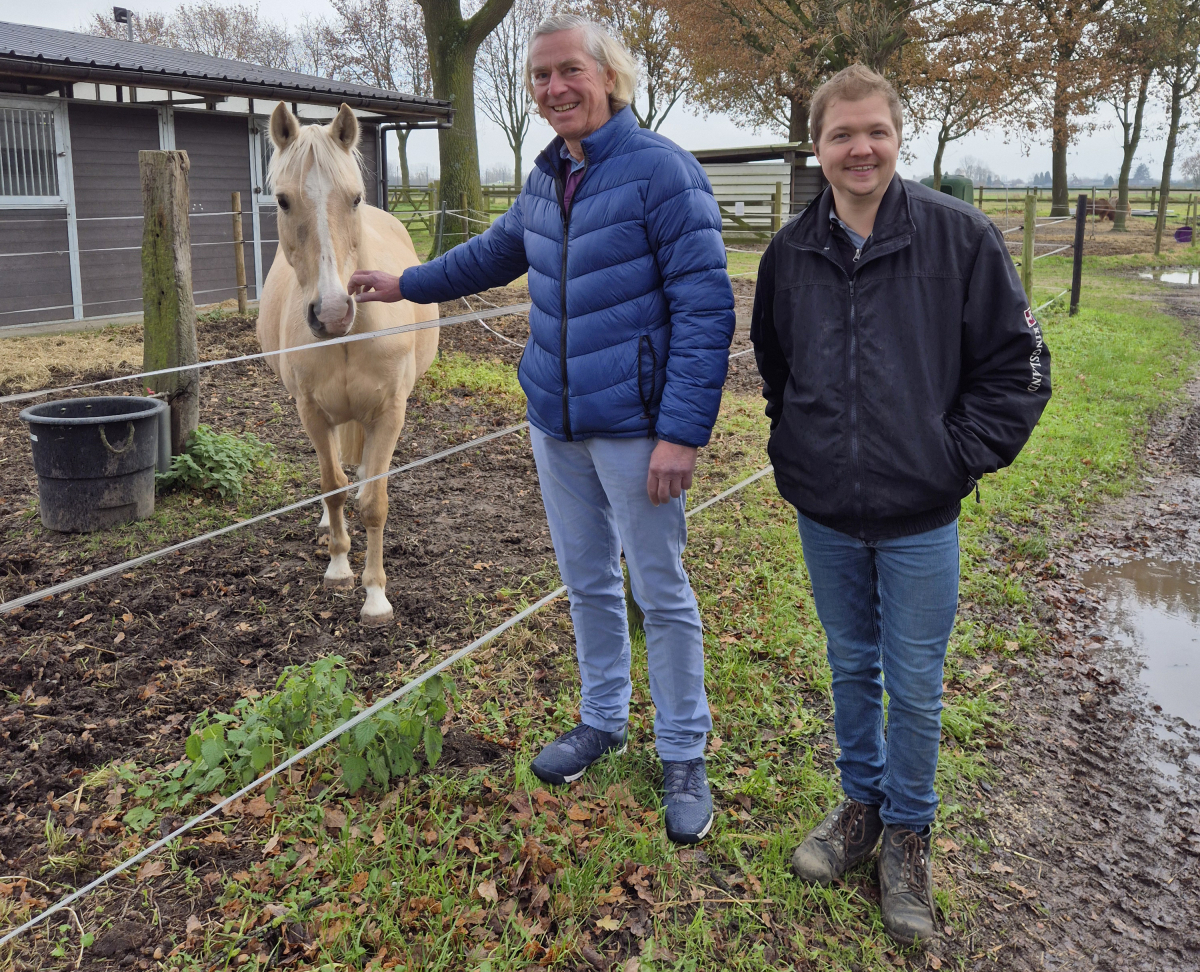 |
| Chairman Didier Tytgadt (left) and coordinator Laurens Van Hoof (right) |
Didier
I can strongly relate to what Dominique just said. I was raised in a very strict environment, and horses became a true outlet for me.
"A horse has an incredible ability to sense a person's emotional state. There’s a genuine exchange between the two - a person can help calm a horse, but just as often, the horse provides a calming influence in return."
Could you briefly describe where we are?
Laurens
We are currently in the meeting room of the equestrian centre Dennenhof in Landegem, a borough of Deinze. Our riding school is actually a hippotherapy centre, for adults and children with and without disabilities.
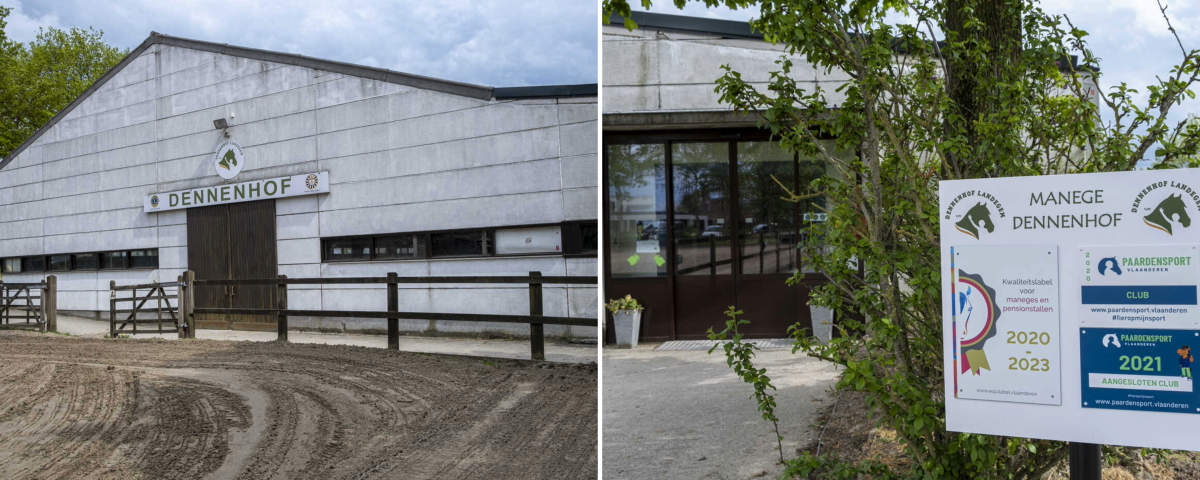
When was Manege Dennenhof established?
Didier
Officially in March 1983: that's when the statutes of the “vzw” (non-profit organisation) appeared in the Official Gazette.
Actually, the roots of our work go back to 1976 when Vincent Marecaux began using horses as part of his physiotherapy practice. Fresh out of school, he started by using the meadow next to Ten Dries to help people with disabilities experience the benefits of riding. It began modestly with just one horse, then grew to two, and continued expanding from there.
Later, Dr. Eric Veys spearheaded a major sponsorship campaign to raise funds for a covered riding arena, enabling therapeutic activities to continue year-round, regardless of the weather.
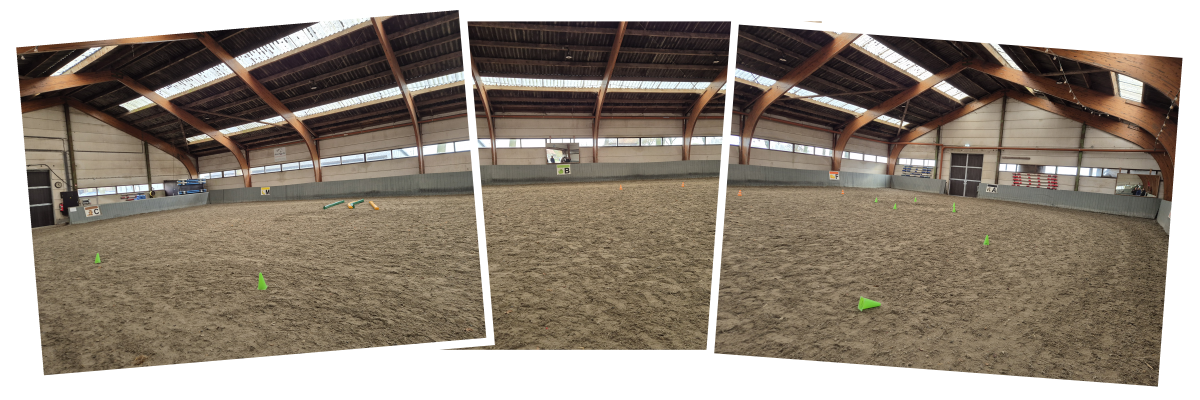
How many people work here full time?
Didier
Permanently employed, there are three: Laurens, Kim our equine therapist, and Maïté our animal carer.
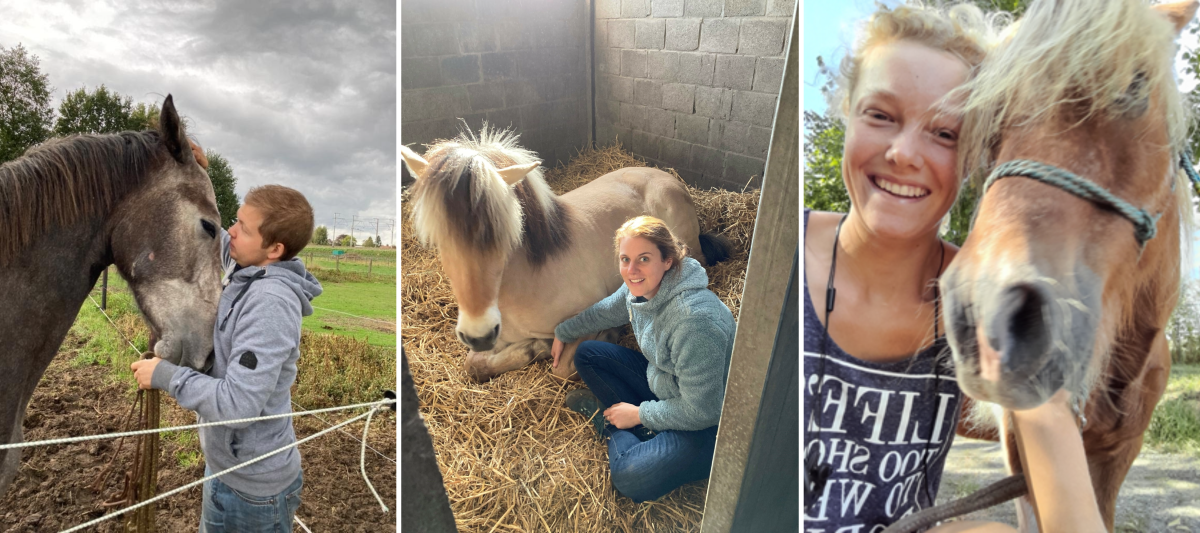
Laurens
In addition to our core team, we have about 12 volunteers who come in weekly to support us for half a day. They assist with tasks like walking the horses and taking care of them.
We’re also fortunate to have around 10 ‘supervised workers.’ These are individuals with a mental disability who are physically very capable. They contribute significantly by mucking out stables, bringing in fresh straw, feeding hay, and leading the horses to and from the pasture, among other tasks.
Besides hippotherapy, employment care is the second key service we offer. Our supervised workers require some level of guidance, as they are not able to work entirely independently.
To support them, we’ve developed a colour-coded system that is used throughout the centre. This system helps them identify the correct equipment for each horse and ensures that everything is put back in its proper place afterward. Even the combs for grooming the horses are colour-coded (laughs), which makes the process much more intuitive and manageable for everyone involved.
Didier
Indeed, the social mission of our stables extends far beyond hippotherapy. We strive to ensure that individuals with mild mental disabilities also have the opportunity to actively participate in society. By engaging in meaningful tasks, they can stay active, contribute, and experience the sense of purpose that comes from feeling useful.
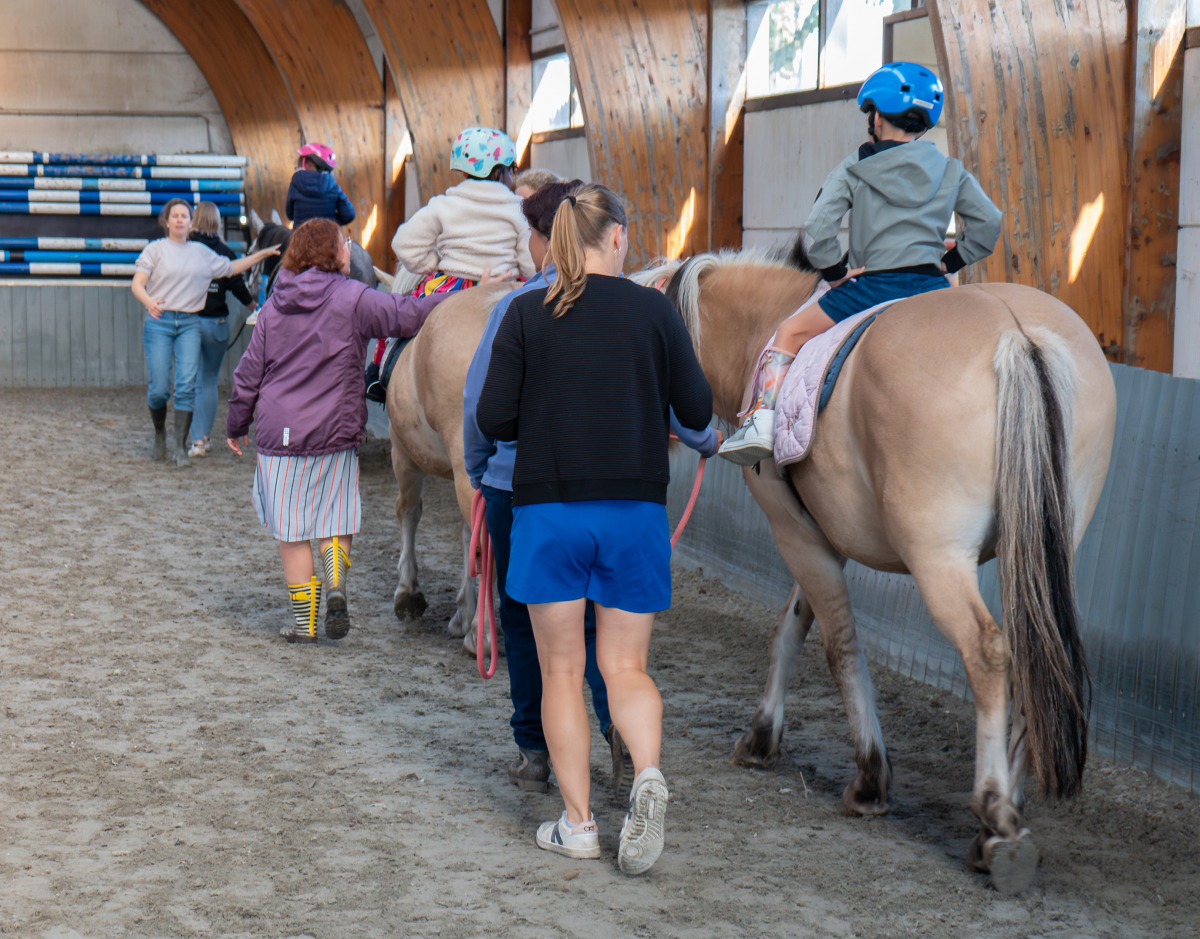
What exactly does hippotherapy entail?
Laurens
Hippotherapy is a broad term that encompasses various approaches. It can be viewed from a psychological perspective, focusing on mental well-being, or from a physiotherapy standpoint, aimed at improving motor skills. Often, it’s a combination of the two.
At Manege Dennenhof, our primary focus is on the motor aspect rather than providing mental coaching or psychological counseling.
- We work with patients who experience significant muscle tension, using the horse's rhythmic movements to help relieve it.
- Others, often confined to wheelchairs, struggle with core stability due to underdeveloped abdominal muscles and difficulty standing. On a horse, there’s no chair to lean against, so they must actively engage these weaker muscles, encouraging strength and improved posture.
We also focus on improving balance through various exercises, such as using the arms, playing with a ball, and similar activities.
Another key element is fostering body awareness. For example, we guide participants with instructions like, ‘Place your left hand on your right shoulder’.
Of course, the mental aspect naturally plays a role as well. People feel good when they’re on a horse—they experience a sense of connection and unity with the animal, which enhances their overall well-being.
"Our patients are often accustomed to being in a wheelchair, looking up at the world around them. But when they’re on a horse, everything changes - they’re elevated, seeing the world from above."
That mental aspect is so important: feeling like ‘lord and master’ for a moment. Knowing, ‘I can do something here; I am doing something here.’ Realising that you want to get from A to B and, instead of being pushed in a wheelchair, being able to get to B yourself with your horse. It’s a profound difference—having the autonomy to choose where you want to go versus relying on someone else to push you.

Didier
And the physical contact with the horse itself cannot be underestimated. Most of our horses are not saddled—we want the patients to feel the horse's warm body directly. That sensation, almost like skin-to-skin contact, is incredibly important. It’s akin to the importance of physical contact between people.
Our horses are remarkably attuned to the riders’ limitations and respond with great sensitivity. The benefits for the patients go beyond the purely kinetic - improving their back and overall musculature. Mentally, it provides a tremendous boost.
All these elements contribute to enhancing the patients' well-being. It builds their self-confidence as they experience a sense of dominance over such a powerful animal. That realisation—that they are not entirely subservient or dependent—gives them the confidence to believe they can accomplish things on their own!
| Want to know more about hippotherapy? Then be sure to check out the new series on HippoTV. |
|---|
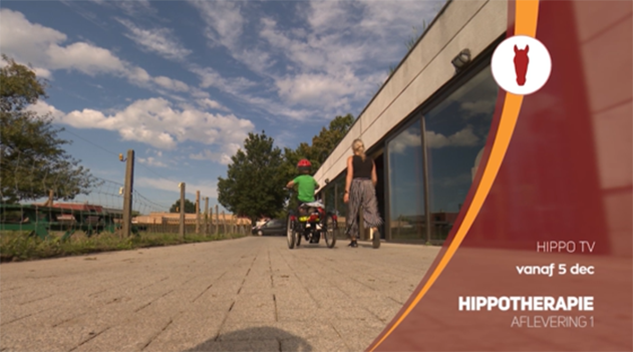 |
Can you give a few more details about such a hippotherapy session?
Laurens
A session typically lasts about 30 minutes. We keep the duration limited because longer sessions, such as an hour, would place too much physical strain on the patients, whose muscles often cannot handle such extended exertion.
We tailor each session to the individual patient’s needs. For example, a child with significant muscle tension but an underlying weak muscular system may initially sit upright due to that excess tension. As the tension relaxes, however, they may begin to slouch or lean more. It’s then up to us to carefully evaluate whether we can extend the session by another minute or two.
How many horses do you have in total?
Laurens
There are 13 therapy horses here at the centre, specifically trained to assist with our sessions. In addition, we have 10 stables that we rent out to individuals seeking boarding for their own horses. The monthly fees from these rentals contribute to covering our operational costs, helping to sustain the centre and its activities.
Do you select the horses according to the patient’s needs?
Laurens
That's a very good question. The answer is yes (laughs). We carefully match each patient to a suitable horse. For example, we wouldn’t assign a wide horse to a patient with limited leg spread, nor would we place someone who requires significant support on a tall horse, as providing that support would become impractical.
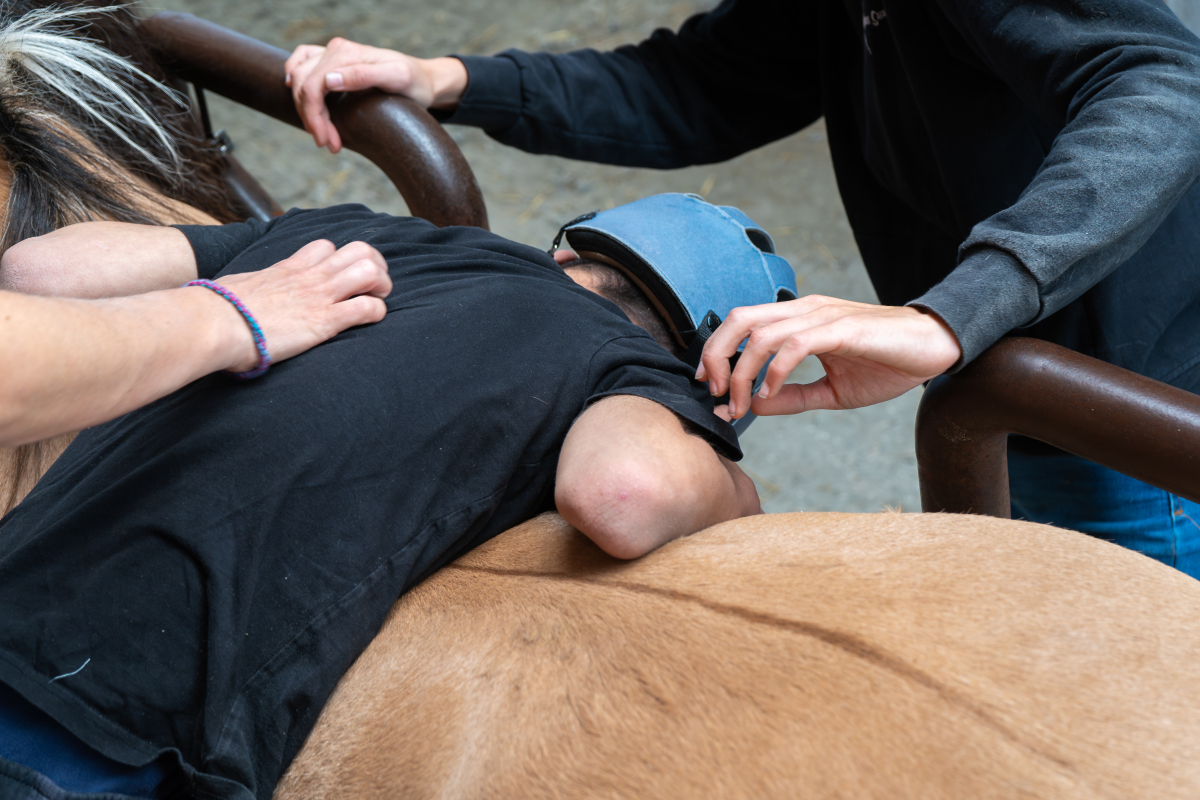
So, you work closely with the care centres, because I hear you say that every patient has different needs?
Laurens
Due to GDPR legislation, we ourselves do not have access to our clients' medical records. But of course, the care centres themselves do. So, they come to us and say ‘look, this patient has this particular issue’. Then we engage in dialogue to see where we can help or not.
What is very important to mention is that of every patient, the treating physiotherapist comes along from time to time anyway. There must be consultation between what the physiotherapist does with the patient on a daily basis, in the care centre or practice, and how we fit in with this hippotherapy.
We rely heavily on feedback from the physiotherapist. For example, if a patient has been prescribed new medication, such as additional muscle relaxants, it’s crucial for us to know this before their session on the horse.
At the equestrian centre, we have a large board—a kind of grid—that displays the names of the scheduled patients alongside the horses assigned to them for the day. Based on the physiotherapist's feedback, we adjust the horse assignment accordingly. This is also where our colour-coded system, as mentioned earlier, comes into play, helping us ensure everything is well-organised and tailored to each patient’s needs.
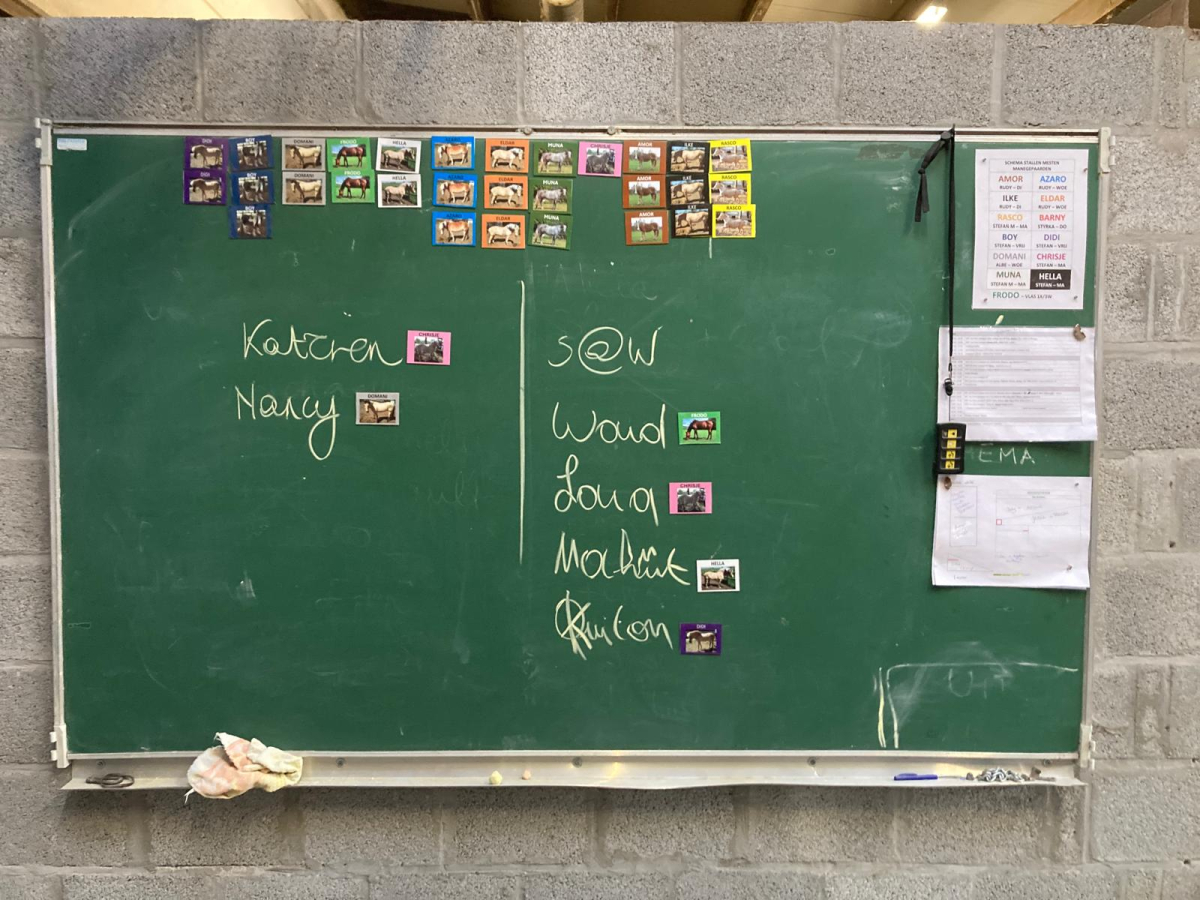
So, a client can interact with different horses?
Laurens
Yes, but it really depends on the individual patient. Some clients need to ride the same horse consistently, while others are happy to change as long as the horse matches a specific ‘type,’ like a slow walker, for example.
For some clients, there’s a strong emotional bond with a particular horse, making it very challenging for them to switch to another. In such cases, we often stick to the same horse to maintain that bond. However, we do occasionally introduce a different horse on purpose. Why? Because sometimes a horse might not be available—whether due to illness or injury. Building a bit of flexibility ensures that the sessions can continue even if their preferred horse isn’t available.
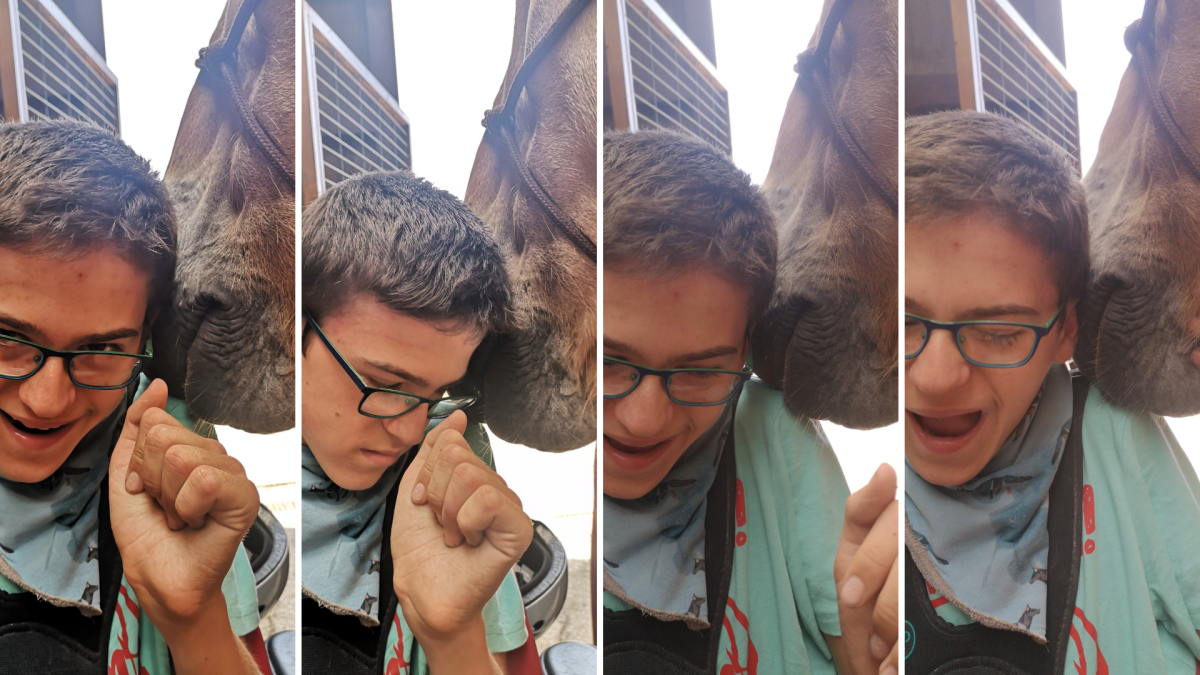
But of course, we deeply respect the emotional bond between humans and animals. For example, we have a girl here who was really struggling with herself. At the riding school, we have a horse named Azaro, who is what you might call ‘hyperkinetic’ (laughs)—he never stands still and is always eager to work. We honestly never thought it would click between the two. But then, out of nowhere, this girl wrapped her arms around Azaro’s neck, and they stood there cuddling for 15 minutes. We were absolutely amazed because, normally, Azaro wouldn’t stand still for more than two minutes. Yet, that connection happened, and it was incredible to witness.
How do the horses get here? How do you select them?
Laurens
We often work with the same horse dealer and have an arrangement that allows us to ‘test’ a potentially suitable horse for a few months.
A horse must meet two key criteria: it needs to be physically suitable for hippotherapy—healthy and well-built—and it must also enjoy the sessions. It’s essential that the horse remains calm and doesn’t become nervous around noise or frightened by things like a wheelchair.
We gradually introduce the horse to hippotherapy to see how it adapts. If the match is successful, we send the horse to our vet for a final health check. Once the vet gives the green light, we proceed with purchasing the horse
Sometimes, we also hear about an opportunity—a potentially suitable horse available somewhere. In those cases, we still aim to secure the horse for a trial period. It’s important to recognise that removing a horse from its familiar environment is a significant adjustment for the animal.
During the first week with us, it’s impossible to judge whether the horse is suitable for hippotherapy. That time is purely for the horse to acclimatise to its new surroundings. We keep things very low-key—showing the horse the stable, the arena, and the meadow, and maybe brushing it once. That’s all.
In the second week, we let the horse observe a therapy session, but without a patient. If that goes well, we introduce it to the mounting bridge where patients get on, ensuring the horse is comfortable with the process.
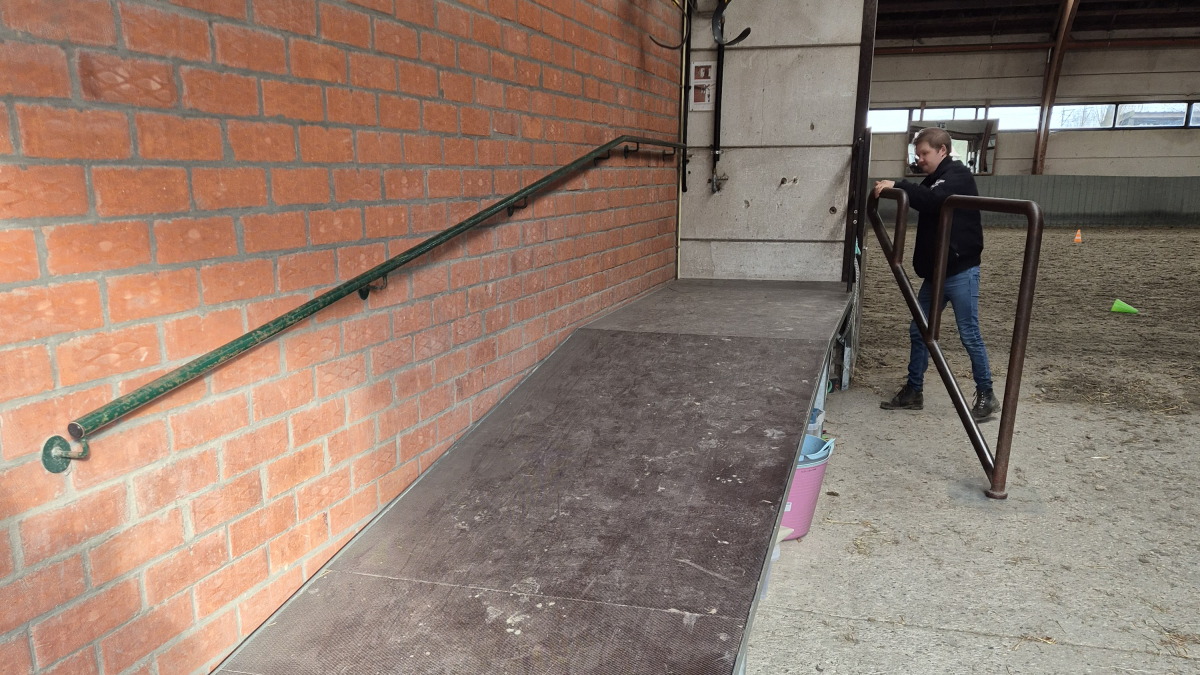
We observe whether the horse stays calm and still while positioned at the mounting bridge. If it does, we reward the horse, often feeding it between the bridge to provide positive reinforcement. This process helps the horse associate the experience with something pleasant. After about a month, we can usually assess whether the horse is likely to succeed in this role, though it can take as long as six months for a horse to become fully familiar and comfortable in its new environment.
Do horse handlers have to meet certain requirements?
Laurens
Yes, absolutely. We always begin with an introductory meeting to understand their motivation. It’s essential that a volunteer genuinely enjoys what they’ll be doing—there needs to be a good ‘match.’
Experience with horses is, of course, important. Additionally, a clean criminal record is a requirement. Volunteers must also have a positive attitude towards working with people with disabilities.
Once these criteria are met, we begin the onboarding process. Initially, we provide extensive guidance to ensure they feel confident and understand their tasks. Over time, as they gain experience, we gradually reduce our supervision, allowing them to work more independently.
Can you share some successes or positive changes you have observed? For example, how do you measure patient progress?
Laurens
A great example is a rider who started in a duo seat, where he sat on the horse with me behind him, providing full support. Over three years, we were able to transition him, step by step, towards significant autonomy.
By gradual, I mean starting with me holding him securely at the pelvis. Later, I reduced my physical support, eventually letting go completely. From there, he progressed to sitting independently on the horse, but with an attendant on both sides of the horse, each holding a stirrup for added security. We then moved to just one stirrup for support, and now he rides confidently with reins.
Of course, there are cases where we can’t aim for such ambitious progress. For many individuals with disabilities, particularly as they reach 40-45 years of age, a gradual decline in physical ability can occur. In those cases, our goal shifts to maintaining their current abilities and preventing regression for as long as possible.
Even that can be incredibly rewarding. For example, when we see that patient X started with us at 40 and is still riding at 60, it’s deeply satisfying to know that, without hippotherapy, they may not have been able to stand there again. Supporting and sustaining their abilities over time is just as meaningful as any breakthrough.
"And there are so many little moments of happiness…"
I vividly remember a moment with a boy I had never been able to connect with before. During one session, I picked up a ball to use as part of the activities. Suddenly, the boy started chatting—and he didn’t stop (laughs). That little ball must have triggered something in him. It was incredible to witness such a breakthrough.
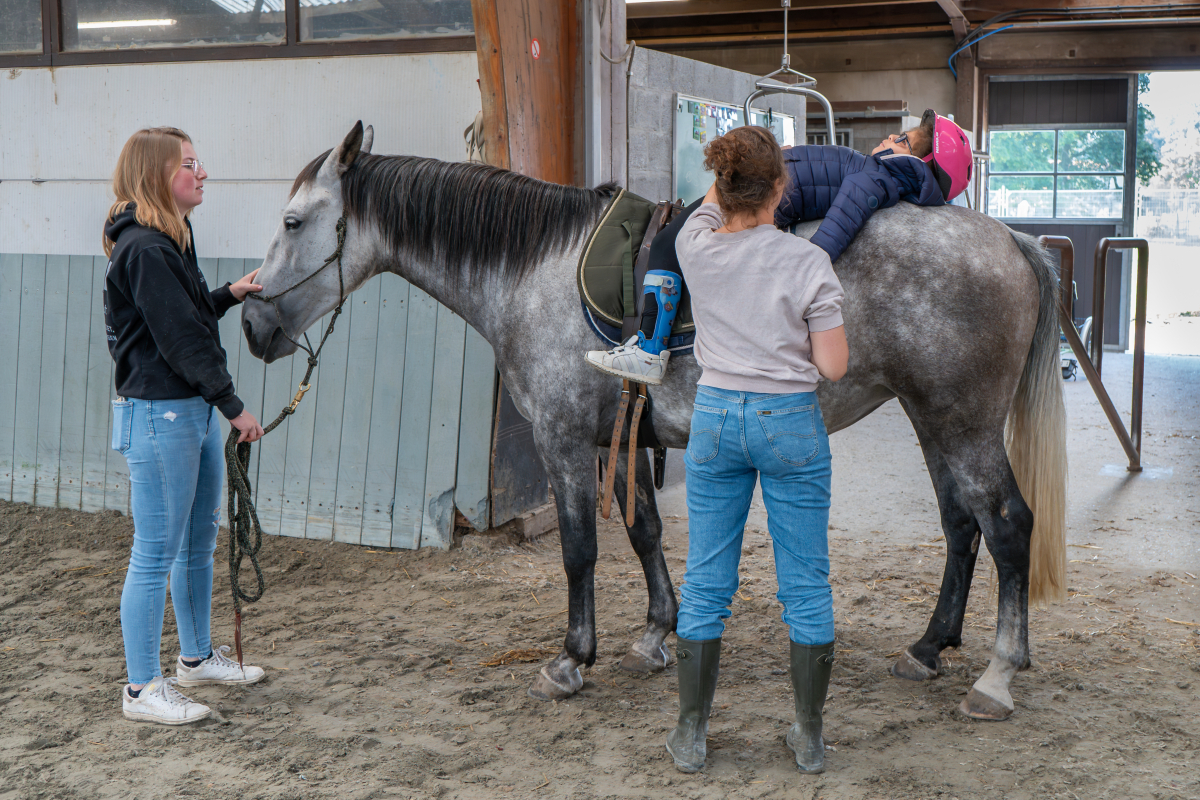
Do friends and family members also come with the patients? If you're talking about those happy moments, I can imagine they would want to experience that too.
Laurens
Yes, absolutely. Sometimes we organise sessions where parents join their child, or family members drop by spontaneously because they know their cousin is riding, for example. Even grandparents might come along, have a coffee, and watch the session.
A hippotherapy session is always an ‘event’ in itself (laughs).
Care facility attendants often record videos or take photos during sessions, which are then shared with the patients’ loved ones. Many care centres also have weekly newsletters or updates where these stories are included, helping to keep the family closely involved.
How do these people get here? I mean both patients and companions?
Laurens
People can sign up through our website, but most of our patients come to us via the care cenrtres we’ve been collaborating with for over 30 years. There’s no shortage of interest—we actually have to work with a waiting list.
As for volunteers, we recruit through platforms like vrijwilligerswerk.be (volunteering work), which helps connect us with people eager to contribute.
And also through word of mouth. For example, my father is retired and said, ‘I want to come and volunteer half a day a week.’ His neighbour heard about it and decided to join as well. My father is also part of a driving club where he rides a carriage, and someone from there got interested too. It just keeps spreading. Now, on Tuesday afternoons, four pensioners meet here. They help us with heart and soul.
We have volunteers of all kinds—some love working with horses, while others don’t but have skills like being handymen. We need them all, and we are incredibly grateful for their support.
So how long do patients keep coming back?
Laurens
There are people who have been coming here for 30 years. This is especially true for our adult clients, where it’s common for them to continue attending for many years. In fact, some of our clients were known to my father when he was an occupational therapy trainee.
With children, it can vary more. Sometimes changes in schooling, such as moving from primary to secondary education, result in them suddenly stopping their sessions.
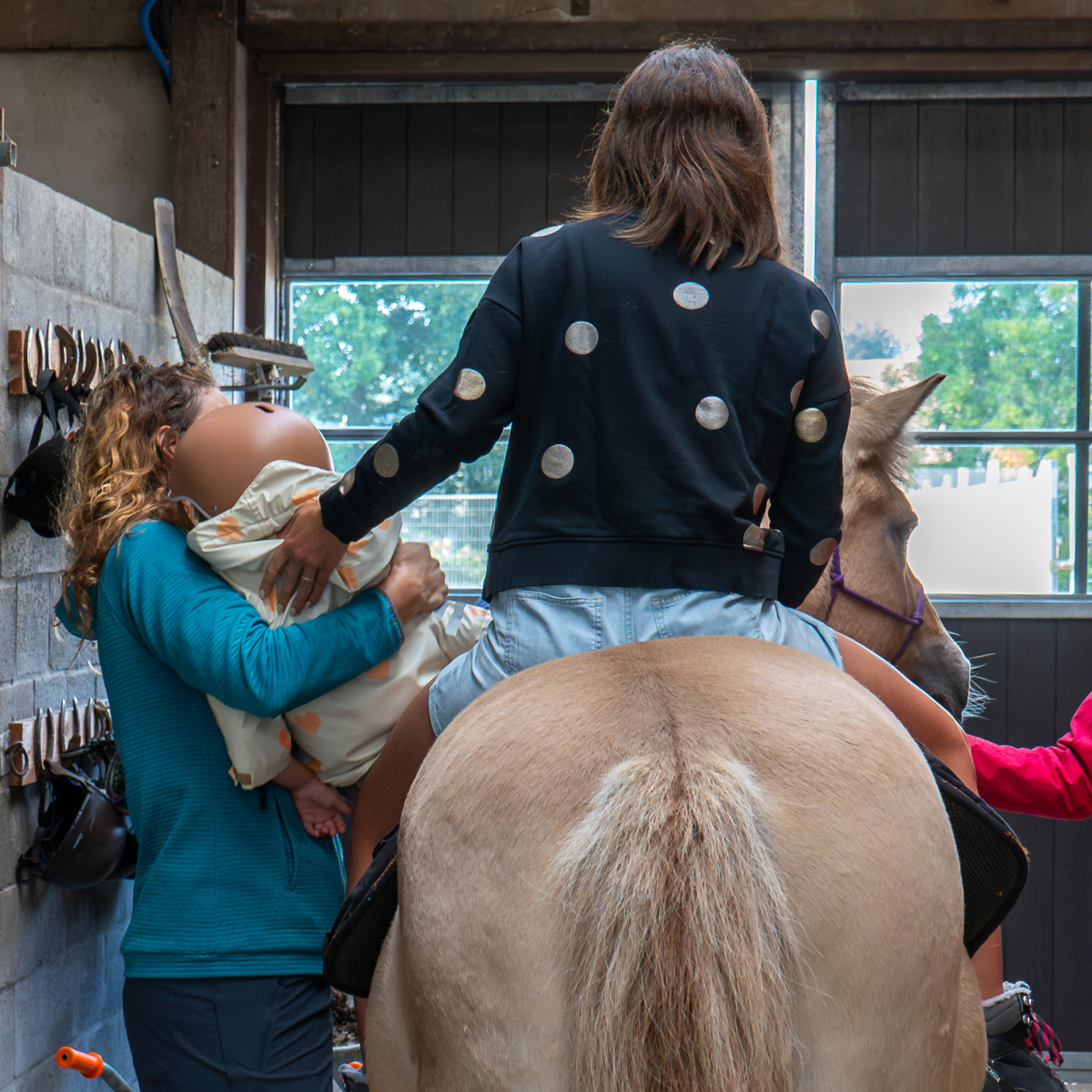
Where do you get the money to keep everything running?
Didier
You know, we receive absolutely no government subsidies. Our biggest sponsors are Lions Club Ghent and Round Table 3 Ghent, both of which have representatives on our Board of Directors, along with MFC Ten Dries.
Each year, we rely heavily on fundraising and sponsorship activities to generate the funds we need. For example, we recently organised a campaign selling tomates farcies (stuffed tomatoes) in collaboration with Chef Dimitri Vinois from à Table.
That said, it’s becoming increasingly challenging. People everywhere are cutting back on spending. Still, we do everything we can to keep going—for the sake of our patients. After all, it’s in our statutes:
"Our non-profit organisation's core mission is to support people with disabilities through hippotherapy."
Laurens
Additionally, we can’t charge patients the full amount that a single hippotherapy session actually costs us. The budgets allocated to people with disabilities by the government are far from sufficient. We often compare it to a small backpack filled with pennies—they have to use it to cover all their care expenses, such as their stay in a care institution, as well as physiotherapy, speech therapy, and so on. What little is left in that ‘backpack’ can be spent on hobbies or leisure activities, but it’s rarely enough to afford something like hippotherapy.
If we were to charge the real cost price, most patients simply wouldn’t be able to afford it. That’s why we charge a very social rate, which means we have to find other ways to cover our expenses.
Didier
When a patient comes here, two attendants are always required: one to guide the horse and another to assist the patient directly, for example, by helping them maintain balance. Yet, we only charge €13.00 per session, even with two attendants involved. This rate is far below what the actual cost of a session is.
I have read that you work with sponsorship packages, among other things. Can you tell us a bit more about that?
Laurens
Yes, that’s correct. Companies and service clubs can sponsor us by covering specific annual costs, such as the expenses for one horse. This includes things like the farrier, vet visits, and other care needs. Essentially, they take on the sponsorship of a horse.
In return, we place a plaque or inscription at the stables to acknowledge their support and show our appreciation.
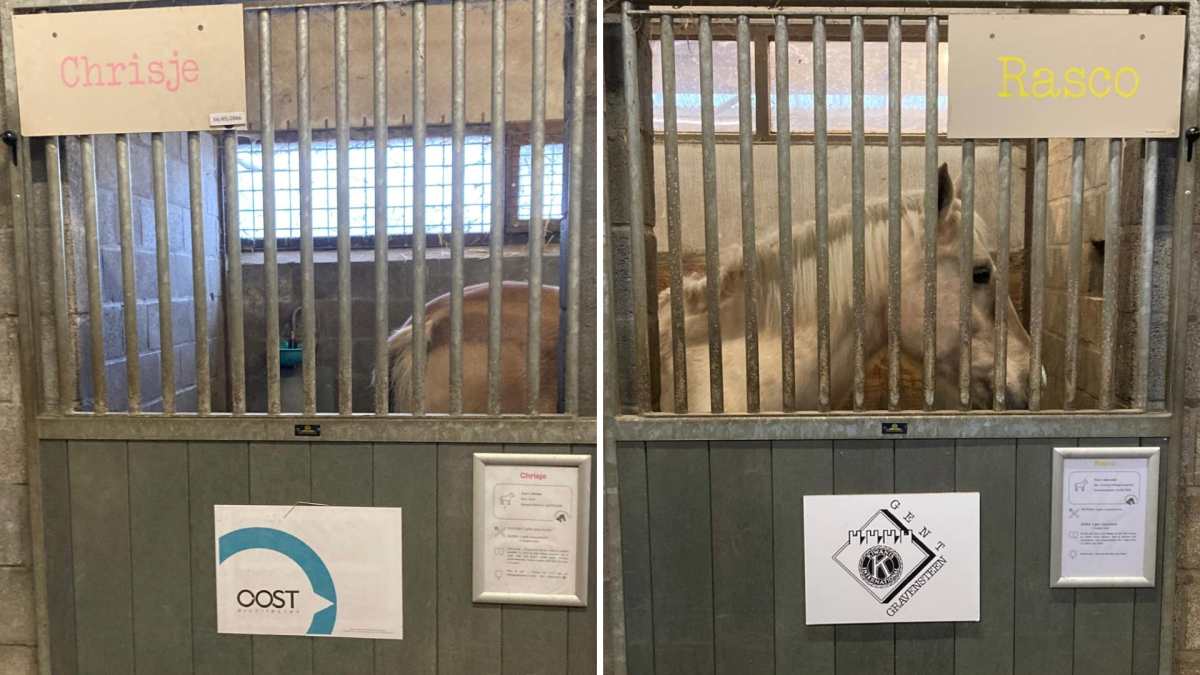
Above all, we also strive to involve our sponsors. We invite them to attend a therapy session or, for example, host their own meetings with their members here at the equestrian centre. While it’s wonderful to receive financial support, it’s equally important to involve people, be transparent, and show them exactly how their contributions are making a difference.
What does the future look like? Suppose we come back in 50 years: what does the ideal picture look like?
Laurens
In an ideal future, hippotherapy would be officially recognised and supported by the government. Right now, we do everything we can to make it as accessible and affordable as possible, but only a few centres can achieve this.
We often see small initiatives offering hippotherapy, but it’s simply unaffordable for most clients. Our fee of €13.00 per session—which covers the cost of maintaining the horse and two attendants—doesn’t come close to covering the actual costs (laughs).
Didier
In our neighbouring countries, hippotherapy is indeed better recognised. Our ultimate dream is to receive government support and subsidies. It’s frustrating—not just from a financial standpoint but also because what we do genuinely adds significant value for our patients. The lack of recognition feels like a missed opportunity to make this therapy more accessible to those who need it.
Laurens
There is a professional association for hippotherapy (beroepsvereniging voor hippotherapie), which we are a member of, but even they face challenges when dealing with the government in this area. It’s difficult for them as well.
In fact, there are only about three centres like ours that serve approximately 100 clients weekly. Most other members of the professional association are individuals working in hippotherapy as a secondary occupation, often charging very high rates. This might make the government hesitant to provide subsidies, as they may not differentiate between large, accessible centres like ours and smaller, more exclusive practices.
We share your hope for the swift recognition you truly deserve. What you are doing here is incredibly impressive and inspiring. Wishing you the very best of luck and countless new happy moments in the future!
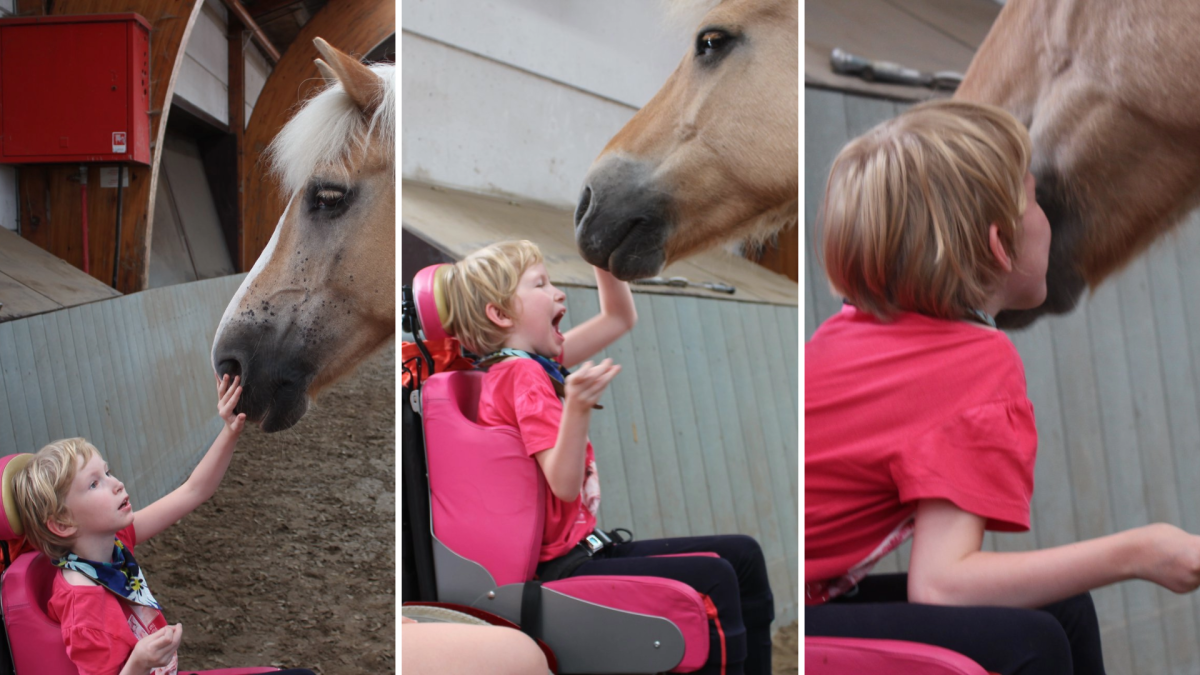
More information about non profit organisation Manage Dennenhof?
Coordinator Laurens Van Hoof
Dennendreef 64
9850 Landegem, Belgium
T: 09 371 94 47
E: info@manegedennenhof.be
W: www.manegedennenhof.be
| Donations to bank account: BE65 7330 6254 2596 |
|---|
If you know someone who would also like to read this article, feel free to copy the link and share.
Do you also want to help people with disabilities get in the saddle?
It’s possible!
By making a donation on the account number of Dennenhof vzw: BE65 7330 6254 2596
All donations go entirely to charity.
Follow our adventures closely in our blog here:
Team TerraCottem walks for charityFollow our adventures closely in our blog here:
Team TerraCottem walks for charityTerraCottem Intl. SL
Apartado de Correos 4511190 Benalup (Cádiz)Spain
